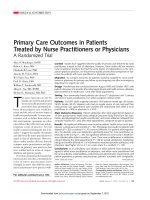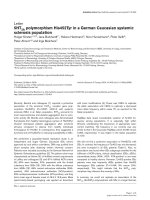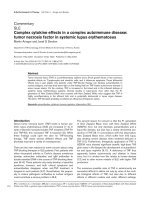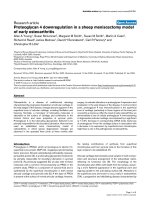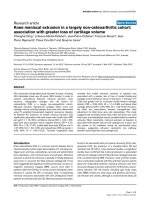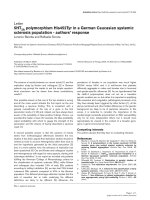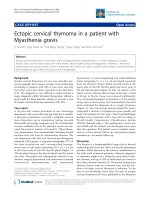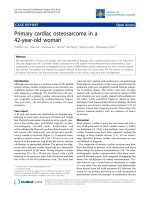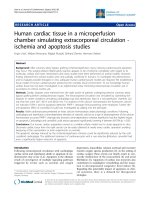Báo cáo y học: "roteoglycan 4 downregulation in a sheep meniscectomy model of early osteoarthritis" docx
Bạn đang xem bản rút gọn của tài liệu. Xem và tải ngay bản đầy đủ của tài liệu tại đây (1.21 MB, 6 trang )
Open Access
Available online />Page 1 of 6
(page number not for citation purposes)
Vol 8 No 2
Research article
Proteoglycan 4 downregulation in a sheep meniscectomy model
of early osteoarthritis
Allan A Young
1
, Susan McLennan
2
, Margaret M Smith
1
, Susan M Smith
1
, Martin A Cake
3
,
Richard A Read
3
, James Melrose
1
, David H Sonnabend
1
, Carl R Flannery
4
and
Christopher B Little
1
1
Raymond Purves Research Laboratory, Institute of Bone and Joint Research, Royal North Shore Hospital, University of Sydney, Pacific Highway, St
Leonards, NSW 2065, Australia
2
Department of Endocrinology, Royal Prince Alfred Hospital and Department of Medicine, University of Sydney, Missenden Road, Camperdown,
NSW 2050, Australia
3
School of Veterinary and Biomedical Sciences, Murdoch University, South Street, Murdoch, WA 6150, Australia
4
Wyeth Research, 200 Cambridge Park Drive, Cambridge, MA 02140, USA
Corresponding author: Allan A Young,
Received: 23 Nov 2005 Revisions requested: 20 Dec 2005 Revisions received: 10 Jan 2006 Accepted: 12 Jan 2006 Published: 31 Jan 2006
Arthritis Research & Therapy 2006, 8:R41 (doi:10.1186/ar1898)
This article is online at: />© 2006 Young et al.; licensee BioMed Central Ltd.
This is an open access article distributed under the terms of the Creative Commons Attribution License ( />),
which permits unrestricted use, distribution, and reproduction in any medium, provided the original work is properly cited.
Abstract
Osteoarthritis is a disease of multifactorial aetiology
characterised by progressive breakdown of articular cartilage. In
the early stages of the disease, changes become apparent in the
superficial zone of articular cartilage, including fibrillation and
fissuring. Normally, a monolayer of lubricating molecules is
adsorbed on the surface of cartilage and contributes to the
minimal friction and wear properties of synovial joints.
Proteoglycan 4 is the lubricating glycoprotein believed to be
primarily responsible for this boundary lubrication. Here we have
used an established ovine meniscectomy model of
osteoarthritis, in which typical degenerative changes are
observed in the operated knee joints at three months after
surgery, to evaluate alterations in proteoglycan 4 expression and
localisation in the early phases of the disease. In normal control
joints, proteoglycan 4 was immunolocalised in the superficial
zone of cartilage, particularly in those regions of the knee joint
covered by a meniscus. After the onset of early osteoarthritis, we
demonstrated a loss of cellular proteoglycan 4 immunostaining
in degenerative articular cartilage, accompanied by a significant
(p < 0.01) decrease in corresponding mRNA levels. Early loss
of proteoglycan 4 from the cartilage surface in association with
a decrease in its expression by superficial-zone chondrocytes
might have a role in the pathogenesis of osteoarthritis.
Introduction
Proteoglycan 4 (PRG4), which is homologous to lubricin [1],
superficial zone protein (SZP) [2], megakaryocyte-stimulating
factor precursor [2] and camptodactyly-arthropathy-coxavara-
pericarditis protein [3], is a lubricating glycoprotein believed to
be primarily responsible for boundary lubrication in synovial
joints [4]. As previously suggested [5], we also refer to these
molecules with a common immunoreactivity as PRG4 in the
present study. PRG4 is a component of synovial fluid and is
synthesised by the superficial chondrocytes in both normal
articular cartilage and synovial cells [6]. A thin layer of PRG4
is present at the surface of normal articular cartilage; however,
the relative contributions of synthesis from superficial
chondrocytes and from synovial cells to the formation of this
layer remains to be established [7].
Articular cartilage demonstrates zonal variation in both compo-
sition and structural arrangement of the extracellular matrix,
reflecting its functional role [8]. The morphology of the
chondrocytes also differs with depth from the surface, assum-
ing a more flattened appearance in the superficial zone and
aligning parallel to the articulating surface [8]. Alterations in
the superficial zone are known to occur early in osteoarthritis
(OA), a progressive and debilitating disease characterised by
COV = normally covered; IL = interleukin; LTP = lateral tibial plateau; MTP = medial tibial plateau; OA = osteoarthritis; PCR = polymerase chain
reaction; PRG4 = proteoglycan 4; TGF = transforming growth factor; UNCOV = normally uncovered.
Arthritis Research & Therapy Vol 8 No 2 Young et al.
Page 2 of 6
(page number not for citation purposes)
degeneration and loss of articular cartilage. Proteolytic degra-
dation of the extracellular matrix and alterations in resident
chondrocyte synthetic activity results in disruption of the struc-
tural integrity of articular cartilage. Increased apoptosis, or pro-
grammed cell death, is also observed in OA and to a greater
extent in the superficial zone(s) [9].
Deficiency of PRG4 results in a loss of the chondroprotection
normally provided to articulating surfaces; it has therefore
been implicated in the pathogenesis of OA [10,11]. PRG4 has
been shown to still be present in late-stage human OA [7];
however, little is known about the turnover of PRG4 during the
early stages of the disease process. The aim of the present
study was therefore to determine the changes in cartilage
PRG4 expression and immunolocalisation occurring early in
the pathogenesis of OA with the use of an established animal
model. We also sought to evaluate regional patterns of PRG4
expression and localisation across the ovine knee joint.
Materials and methods
Animal model
Twelve four-year-old female pure-bred Merino sheep were
used for this study. Six of the sheep underwent open lateral
meniscectomy of both stifle (knee) joints as described previ-
ously [12], and the other six underwent a sham operation iden-
tical in all aspects except that the lateral meniscus was not
excised. After recovery from surgery, the animals were main-
tained in an open paddock for three months before being
killed. The protocol used for this study was approved by the
animal ethics committee of Murdoch University (AEC 832R/
00).
Tissue preparation and histology
Full-depth articular cartilage was harvested from the medial
tibial plateau (MTP) and lateral tibial plateau (LTP) in regions
normally covered (COV) and uncovered (UNCOV) by menisci
from either the right or left stifle joint, randomly selected (Fig-
Figure 1
Sheep meniscectomy model of early osteoarthritis (a) Schematic representation of left ovine tibial plateau demonstrating medial (MTP) and lateral (LTP) plateaux, further separated into regions normally covered (COV) and uncovered (UNCOV) by menisciSheep meniscectomy model of early osteoarthritis (a) Schematic representation of left ovine tibial plateau demonstrating medial (MTP) and lateral
(LTP) plateaux, further separated into regions normally covered (COV) and uncovered (UNCOV) by menisci. Full-thickness coronal sections were
taken for histological evaluation as indicated by the broken line. (b) Photographs demonstrating typical osteoarthritic changes observed after lateral
meniscectomy (MEN), including surface fibrillation (arrow) and osteophyte formation (arrowheads).
Available online />Page 3 of 6
(page number not for citation purposes)
ure 1a). Care was taken not to sample tissue from the joint
margins or osteophytes. Tissue samples were snap frozen in
liquid nitrogen before storage at -80°C until required. Coronal
full-thickness osteochondral slabs (5 mm) were prepared
through the mid weight-bearing region of the tibial plateau
from the contralateral joint of each animal (Figure 1a). The
specimens were then fixed, decalcified and processed before
staining with toluidine blue and fast green as described previ-
ously [12]. Histological slides were subsequently evaluated by
two independent observers with a modified Mankin scoring
scheme, previously developed in our laboratory for this ovine
model [12]. The modified Mankin score has a range of 0 to 29,
the value increasing with severity of cartilage degeneration. In
each compartment the worst score evident for the region
examined was used to calculate the mean score (n = 6 for
each group).
Immunohistochemistry
To avoid the necessity for decalcification, articular cartilage
spanning the entire MTP or LTP was micro-dissected as a sin-
gle piece from the underlying subchondral bone after formalin
fixation of osteochondral slabs of two representative sham-
operated and meniscectomised animals, and these full-thick-
ness cartilage specimens were then embedded in paraffin and
4 µm sections were deparaffinised in xylene and graded eth-
anols. Sections were digested with Proteinase K (code no.
S3020; DakoCytomation, Glostrup, Denmark) for six minutes
at room temperature followed by incubation in Protein Block
Serum Free (code no. X909; DakoCytomation) for ten minutes
at room temperature. Primary antibody incubations were per-
formed overnight at 4°C with a 1:600 dilution of 06A10, a pro-
tein A purified rabbit polyclonal anti-PRG4 antibody generated
by immunisation with a truncated form of recombinant human
PRG4 (generously provided by Wyeth Pharmaceuticals, Bos-
ton, MA, USA). This antibody has previously been used to spe-
cifically detect PRG4 in the superficial zone of bovine articular
cartilage [13]. Secondary antibody incubation and colour
development were performed as described previously. The
intensity and number of positively stained cells were evaluated
across the width of the MTP and LTP by two observers [14].
RNA extraction, reverse transcription and real-time
quantitative PCR
About 100 mg of frozen cartilage samples was fragmented in
a Mikro-Dismembrator (Braun Biotech International, Melsun-
gen, Germany). Total RNA was isolated with the RNeasy Mini
Kit (Qiagen, Valencia, USA) and quantified with a fluorimeter
(Perkin Elmer, Beaconsfield, UK) with the use of SYBR
®
Green II colour reagent (Cambrex Bio Science, Rockland,
USA). The quality and integrity of total RNA were assessed on
2% (w/v) agarose gels stained with ethidium bromide. For all
samples total RNA (1 µg) was reverse transcribed into cDNA
with the Omniscript kit (Qiagen, Hilden, Germany) in accord-
ance with the manufacturer's instructions. Real-time PCR was
performed with a Prism 7000 Sequence Detection System
from Applied BioSciences (Foster City, CA, USA). Primers
were designed to bovine PRG4 (ovine sequence 99% homol-
ogous) (forward, 5'-CTGCCCAACATCAGAAAACCC-3' ;
reverse, 5'-TTCCTTCGCCCATCAGTCTAAG-3') (Genbank
accession no. AF056218) and generated a single PCR prod-
uct in sheep, which was confirmed by sequencing
(SUPAMAC, Sydney, Australia). cDNA (1 µl, corresponding to
the reverse transcription of 25 ng of total RNA), 0.5 µl of each
primer (10 µM), 0.5 µl of SYBR green (Molecular Probes, Syd-
ney, Australia) and the Platinum Plus Taq (7 µl; Invitrogen,
Sydney, Australia), with ROX (6-carboxy-X-rhodamine) (0.1 µl)
used as an internal control. The thermal profile was as follows:
50°C for five minutes, 95°C for five minutes, and 40 cycles of
95°C for 15 seconds, 58°C for 30 seconds and 72°C for 30
seconds. Melt curves were also determined to demonstrate
the specificity of the amplification. Standard curves were gen-
erated from plasmids (pGEM Teasy; Promega, Sydney, Aus-
tralia) containing the PCR products, and the linear
amplification range for both plasmid DNA and sample cDNA
was determined. Analysis of the curves showed that the sam-
ple diluted in a parallel manner to the plasmid and that the
cycle threshold (Ct) for all unknown samples fell within the lin-
ear range, allowing quantification of gene copy number relative
to the plasmid concentration. Samples were analysed in tripli-
cate and values were normalised to total RNA as recom-
mended for experiments in vivo involving tissue specimens
[15].
Statistical analysis
Comparisons of non-parametric data from the modified
Mankin histological scoring of the stained tissue sections were
assessed with the Mann-Whitney U test. Statistical evaluation
of significant differences in expression levels was undertaken
with the unpaired Student t test with Benjamini-Hochberg cor-
rection for multiple comparisons.
Results
Gross morphology and histology
Lateral meniscectomy resulted in macroscopic joint changes
characteristic of OA with cartilage fibrillation and erosion, par-
ticularly in the lateral compartment (Figure 1b). The most
severe lesions were confined to the COV region of the LTP,
with surface fibrillation and variable loss of the characteristic
superficial zone cells. Histological grading of the cartilage
specimens confirmed and quantified the regional histological
observations. Modified Mankin scoring was significantly
increased in the LTP COV (4.4 ± 1.2 to 17.6 ± 2.7; mean ±
SD; p < 0.01) and LTP UNCOV (3.1 ± 1.1 to 6.7 ± 1.9; p <
0.01) regions after lateral meniscectomy; however, it remained
unchanged in MTP COV (2.3 ± 0.9 to 4.3 ± 2.6) and MTP
UNCOV (2.6 ± 1.2 to 4.3 ± 1.6) regions.
Immunohistochemistry
PRG4 was immunolocalised to chondrocytes in the superficial
zone of normal cartilage (Figure 2a,c,e,g; positive PRG4 indi-
Arthritis Research & Therapy Vol 8 No 2 Young et al.
Page 4 of 6
(page number not for citation purposes)
cated by red-brown colour) and little or no extracellular matrix
staining was detected. Additionally, positive immunostaining
cells were more prominent in the COV regions of normal car-
tilage than in the UNCOV regions. After meniscectomy, exten-
sive loss of PRG4-positive cells was observed in the
superficial zone of LTP specimens, both COV and UNCOV
regions (Figure 2b,d), corresponding to areas of degenerative
change. No obvious change in PRG4 immunostaining was
observed in the MTP COV and UNCOV cartilage regions after
meniscectomy (Figure 2f,h).
Real-time quantitative PCR
To evaluate whether topographical variation existed in the
expression of PRG4 in normal joints, the ratio of mRNA levels
in the COV versus UNCOV cartilage regions in sham-oper-
ated sheep was evaluated. PRG4 expression was found to be
increased (1.8-fold, p < 0.05) in COV compared with UNCOV
cartilage in the MTP and similarly increased (1.6-fold, p <
0.05) in COV compared with UNCOV cartilage in the LTP
(Figure 3a).
After lateral meniscectomy, PRG4 mRNA levels were found to
be significantly decreased compared with sham-operated
controls in cartilage from the covered region of the LTP (7.0
fold, p < 0.01) (Figure 3b). PRG4 expression was also found
to be decreased in the UNCOV region of the LTP (2.4 fold, p
< 0.05) and in the COV region of the MTP (3.8 fold, p < 0.05).
Discussion
To our knowledge this is the first report describing the immu-
nolocalisation and expression of PRG4 in cartilage in an ani-
mal model of OA. Similarly to previous reports of PRG4
immunolocalisation in normal cartilage [5], in the present study
we observed PRG4-positive cells typically in the superficial
zone and not in the middle and deep zones. The lack of signif-
icant PRG4 staining in the superficial cartilage matrix in com-
parison with previous studies [13] may be related to tissue
processing. The tibial plateaux cartilage underwent biome-
chanical testing before processing for histology. Physical
removal of the surface PRG4 might have occurred during the
15-minute indentation testing, which requires repeated saline
lavage and swabbing of the cartilage surface. After ovine lat-
eral meniscectomy, there was a decrease in PRG4 immunos-
taining with a marked loss of PRG4-positive superficial zone
chondrocytes in the degenerative cartilage of the lateral com-
partment. Importantly, this was not associated with an appear-
ance of PRG4-positive cells in the middle or deep zones of
cartilage. Previous studies performed in late-stage human OA
cartilage collected at joint replacement surgery have reported
the extension of PRG4-positive chondrocytes into the deeper
zones, suggesting potential adaptive responses with disease
progression [7] that were not apparent in the early stages of
OA pathogenesis represented in the present study.
After ovine lateral meniscectomy, the most marked decrease in
PRG4 expression was observed in the lateral compartment
with the most severe histopathological alterations. However,
mRNA levels were decreased in cartilage across the knee joint
after meniscectomy regardless of associated degenerative
changes. Darling and colleagues [16] recently demonstrated
a threefold relative abundance of PRG4 mRNA levels in the
superficial zone of normal articular cartilage. Decreases in the
presence and/or viability of the superficial zone cells occurring
early in the present model of OA therefore probably contrib-
uted to the observed decrease in cartilage PRG4 expression.
Additionally, modulation of the chondrocyte phenotype in
meniscectomised cartilage by mechanical or humoral factors
were likely to have been associated with the downregulation in
PRG4 expression observed in the compartments not undergo-
ing active degeneration.
Topographical variation in PRG4 expression was observed in
normal ovine knee joints in the present study, with increased
expression in cartilage from regions protected by a meniscus,
which was consistent with the immunolocalisation of PRG4
protein. Although a recent report [16] found no variation in
Figure 2
Regional immunolocalisation of proteoglycan 4 (PRG4) with polyclonal antibody 06A10 in ovine tibial plateau cartilageRegional immunolocalisation of proteoglycan 4 (PRG4) with polyclonal
antibody 06A10 in ovine tibial plateau cartilage. Lateral and medial tib-
ial plateaux (LTP and MTP, respectively) from regions covered (COV)
or uncovered (UNCOV) by the meniscus in sham-operated and menis-
cectomised (MEN) joints are shown, including enlarged views of
respective surface zones as insets. Representative PRG4-positive
(arrows) and PRG4-negative (asterisks) chondrocytes are indicated.
Scale bar, 150 µm.
Available online />Page 5 of 6
(page number not for citation purposes)
PRG4 expression across distal femoral cartilage, we have pre-
viously demonstrated that topographical differences in
chondrocyte metabolism were most pronounced in the tibial
plateau [17]. These differences in cartilage metabolism in the
tibial plateau were probably associated with the presence of
the meniscus and its effect on mechanical loading of the car-
tilage. In the present study we postulate that not only variation
in compressive mechanical loads but also potential shearing
between the meniscus and underlying cartilage may modulate
PRG4 expression in this region. Wong and colleagues [18]
have previously demonstrated in chondrocyte-seeded alginate
constructs that cyclic shear loading significantly upregulated
PRG4 expression, whereas cyclic hydrostatic pressure was
associated with a slight downregulation. Alterations in shear
stress after lateral meniscectomy might therefore have contrib-
uted to the decreased cartilage PRG4 expression observed in
the present study.
The mechanisms involved in regulating PRG4 expression and
synthesis remain largely unknown. Increased catabolic path-
ways are present in OA, and the inflammatory cytokine IL-1
seems to be one of the most influential factors, demonstrating
deleterious effects for cartilage in vitro and in vivo, acting to
inhibit proteoglycan synthesis while promoting degradation of
matrix components through both activation of proteases and
stimulation of their production [19-23]. PRG4 seems to be
highly regulated by IL-1, which has been shown to inhibit its
secretion in vitro, and therefore potentially contributing to the
pathogenesis of OA [2,24]. Conversely, it has shown that
transforming growth factor-β (TGF-β) stimulates PRG4 syn-
thesis and may be beneficial for normal cartilage function
[2,24]. TGF-β has a significant role in promoting the anabolic
activity of chondrocytes, and its expression has been reported
to increase in early OA [25,26].
Conclusion
Loss of PRG4, whether by altered synthesis or subsequent
degradation, is likely to influence the functional properties of
synovial joints. A focal decrease in PRG4 in early OA could
have a role in the pathogenesis of cartilage degeneration. In
the present study we have demonstrated in an animal model
that early degeneration of cartilage was associated with the
loss of PRG4 from articular cartilage concomitant with a sig-
nificant decrease in its expression by chondrocytes in the
superficial zone. Modulation of PRG4 in OA joints therefore
provides a new approach to understanding the mechanisms of
disease initiation and progression and offers potential as a
novel therapeutic target for the treatment of this disorder.
Figure 3
Quantitative real-time PCRQuantitative real-time PCR. (a) Topographical variation in proteoglycan 4 (PRG4) expression in sham-operated ('normal') joints as demonstrated by
the ratio of mRNA copy numbers from cartilage normally covered (COV) versus cartilage normally uncovered (UNCOV) by menisci; in each case the
average value is indicated by the line (n = 6). The dotted horizontal line represents the expected ratio of 1 if there were no difference between
regions. (b) PRG4 mRNA copy numbers (means ± SEM) from ovine articular cartilage after lateral meniscectomy (MEN). LTP, lateral tibial plateau;
MTP, medial tibial plateau.
Arthritis Research & Therapy Vol 8 No 2 Young et al.
Page 6 of 6
(page number not for citation purposes)
Competing interests
The authors declare that they have no competing interests.
Authors' contributions
AY designed the study, performed animal surgery, performed
PCR experiments and drafted the manuscript. SM performed
PCR experiments and helped draft the manuscript. MS
designed primers for PCR experiments, performed histopatho-
logical cartilage scoring and helped draft the manuscript. SS
performed histological and immunohistological preparations
and helped draft the manuscript. MC performed animal sur-
gery and helped draft the manuscript. RR performed animal
surgery and helped draft the manuscript. JM assisted immuno-
histological preparations and helped draft the manuscript. DS
was involved in the conception and design of the study and in
the interpretation of the data, and critically revised the manu-
script for important intellectual content. CF critically revised
the manuscript for important intellectual content. CL per-
formed histopathological cartilage scoring, analysed and inter-
preted the data and critically revised the manuscript for
important intellectual content. All authors read and approved
the final manuscript.
Acknowledgements
The authors thank Diana Pethick of Murdoch University for her assist-
ance with the animal handling and care. This study was funded by a
research grant from the Australian Orthopaedic Association Research
Foundation Ltd whose support is gratefully acknowledged.
References
1. Jay GD, Tantravahi U, Britt DE, Barrach HJ, Cha CJ: Homology of
lubricin and superficial zone protein (SZP): products of meg-
akaryocyte stimulating factor (MSF) gene expression by
human synovial fibroblasts and articular chondrocytes local-
ized to chromosome 1q25. J Orthop Res 2001, 19:677-687.
2. Flannery CR, Hughes CE, Schumacher BL, Tudor D, Aydelotte
MB, Kuettner KE, Caterson B: Articular cartilage superficial
zone protein (SZP) is homologous to megakaryocyte stimulat-
ing factor precursor and Is a multifunctional proteoglycan with
potential growth-promoting, cytoprotective, and lubricating
properties in cartilage metabolism. Biochem Biophys Res
Commun 1999, 254:535-541.
3. Marcelino J, Carpten JD, Suwairi WM, Gutierrez OM, Schwartz S,
Robbins C, Sood R, Makalowska I, Baxevanis A, Johnstone B, et
al.: CACP, encoding a secreted proteoglycan, is mutated in
camptodactyly-arthropathy-coxa vara-pericarditis syndrome.
Nat Genet 1999, 23:319-322.
4. Jay GD, Harris DA, Cha CJ: Boundary lubrication by lubricin is
mediated by O-linked β (1–3)Gal-GalNAc oligosaccharides.
Glycoconj J 2001, 18:807-815.
5. Schmidt TA, Schumacher BL, Klein TJ, Voegtline MS, Sah RL:
Synthesis of proteoglycan 4 by chondrocyte subpopulations in
cartilage explants, monolayer cultures, and resurfaced carti-
lage cultures. Arthritis Rheum 2004, 50:2849-2857.
6. Schumacher BL, Hughes CE, Kuettner KE, Caterson B, Aydelotte
MB: Immunodetection and partial cDNA sequence of the pro-
teoglycan, superficial zone protein, synthesized by cells lining
synovial joints. J Orthop Res 1999, 17:110-120.
7. Schumacher BL, Schmidt TA, Bae WC, Wong VW, Temple MM,
Kim TW, Voegtline MS, Chawla K, Chen AC, Bugbee WD, et al.:
Localization and expression of lubricin/superficial zone pro-
tein in human articular cartilage: alterations in osteoarthritis.
Trans Orthop Res Soc 2004, 29:281.
8. Poole AR, Kojima T, Yasuda T, Mwale F, Kobayashi M, Laverty S:
Composition and structure of articular cartilage: a template for
tissue repair. Clin Orthop Relat Res 2001, 391:S26-33.
9. Blanco FJ, Guitian R, Vazquez-Martul E, de Toro FJ, Galdo F: Oste-
oarthritis chondrocytes die by apoptosis. A possible pathway
for osteoarthritis pathology. Arthritis Rheum 1998, 41:284-289.
10. Hills BA: Boundary lubrication in vivo. Proc Inst Mech Eng H
2000, 214:83-94.
11. Rhee DK, Marcelino J, Baker M, Gong Y, Smits P, Lefebvre V, Jay
GD, Stewart M, Wang H, Warman ML, et al.: The secreted glyc-
oprotein lubricin protects cartilage surfaces and inhibits syno-
vial cell overgrowth. J Clin Invest 2005, 115:622-631.
12. Little C, Smith S, Ghosh P, Bellenger C: Histomorphological and
immunohistochemical evaluation of joint changes in a model
of osteoarthritis induced by lateral meniscectomy in sheep. J
Rheumatol 1997, 24:2199-2209.
13. Krishnan R, Caligaris M, Mauck RL, Hung CT, Costa KD, Ateshian
GA: Removal of the superficial zone of bovine articular carti-
lage does not increase its frictional coefficient. Osteoarthritis
Cartilage 2004, 12:947-955.
14. Melrose J, Smith S, Ghosh P: Histological and immunohistolog-
ical studies on cartilage. Methods Mol Med 2004, 101:39-64.
15. Bustin SA: Quantification of mRNA using real-time reverse
transcription PCR (RT-PCR): trends and problems. J Mol Endo-
crinol 2002, 29:23-39.
16. Darling EM, Hu JC, Athanasiou KA: Zonal and topographical dif-
ferences in articular cartilage gene expression. J Orthop Res
2004, 22:1182-1187.
17. Little CB, Ghosh P, Bellenger CR: Topographic variation in big-
lycan and decorin synthesis by articular cartilage in the early
stages of osteoarthritis: an experimental study in sheep. J
Orthop Res 1996, 14:433-444.
18. Wong M, Siegrist M, Goodwin K: Cyclic tensile strain and cyclic
hydrostatic pressure differentially regulate expression of
hypertrophic markers in primary chondrocytes. Bone 2003,
33:685-693.
19. Goldring MB: The role of cytokines as inflammatory mediators
in osteoarthritis: lessons from animal models. Connect Tissue
Res 1999, 40:1-11.
20. Pelletier JP, Caron JP, Evans C, Robbins PD, Georgescu HI,
Jovanovic D, Fernandes JC, Martel-Pelletier J: In vivo suppression
of early experimental osteoarthritis by interleukin-1 receptor
antagonist using gene therapy. Arthritis Rheum 1997,
40:1012-1019.
21. Caron JP, Fernandes JC, Martel-Pelletier J, Tardif G, Mineau F,
Geng C, Pelletier JP: Chondroprotective effect of intraarticular
injections of interleukin-1 receptor antagonist in experimental
osteoarthritis. Suppression of collagenase-1 expression.
Arthritis Rheum 1996, 39:1535-1544.
22. Dumond H, Presle N, Pottie P, Pacquelet S, Terlain B, Netter P,
Gepstein A, Livne E, Jouzeau JY: Site specific changes in gene
expression and cartilage metabolism during early experimen-
tal osteoarthritis. Osteoarthritis Cartilage 2004, 12:284-295.
23. Bunning RA, Richardson HJ, Crawford A, Skjodt H, Hughes D,
Evans DB, Gowen M, Dobson PR, Brown BL, Russell RG: The
effect of interleukin-1 on connective tissue metabolism and its
relevance to arthritis. Agents Actions Suppl 1986, 18:131-152.
24. Schmidt TA, Schumacher BL, Han EH, Klein TJ, Voegtline MS, Sah
RL: Synthesis and secretion of lubricin/superficial zone pro-
tein by chondrocytes in cartilage explants: modulation by TGF-
β 1 and IL-1a. Trans Orthop Res Soc 2004, 29:577.
25. van der Kraan PM, Glansbeek HL, Vitters EL, van den Berg WB:
Early elevation of transforming growth factor-beta, decorin,
and biglycan mRNA levels during cartilage matrix restoration
after mild proteoglycan depletion. J Rheumatol 1997,
24:543-549.
26. Chambers MG, Bayliss MT, Mason RM: Chondrocyte cytokine
and growth factor expression in murine osteoarthritis. Oste-
oarthritis Cartilage 1997, 5:301-308.
